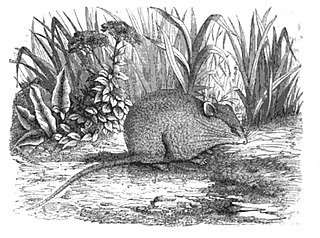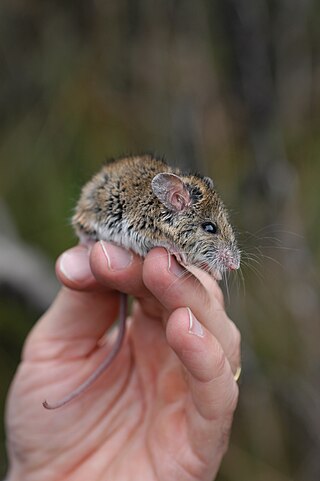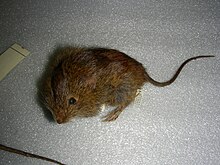
Gould's mouse, also known as the Shark Bay mouse and djoongari in the Pintupi and Luritja languages, is a species of rodent in the murid family. Once ranging throughout Australia from Western Australia to New South Wales, its range has since been reduced to five islands off the coast of Western Australia.

Pseudomys is a genus of rodent that contains a wide variety of mice native to Australia and New Guinea. They are among the few terrestrial placental mammals that colonised Australia without human intervention.

The long-tailed mouse is a native Australian mammal in the Order Rodentia and the Family Muridae. It is found only on the island of Tasmania. The long-tailed mouse is an omnivore that feeds on insects and a range of plants. It is found in forested areas, particularly in sub-alpine scree, and may live in burrows.

The heath mouse is a species of mouse in the subfamily Murinae, the Old World rats and mice, found in Australia.

The ash-grey mouse is a rodent in the family Muridae. Larger and more robust than Mus musculus, the common house mouse, it is found only in Southwest Australia.
The silky mouse is a species of rodent in the family Muridae. It is found only in Australia.

Bolam's mouse is a species of nocturnal, burrowing rodent in the family Muridae that inhabits the semi arid and southern arid regions of Australia. It has a number of physiological and behavioural adaptations developed to cope with an extremely varied climate. Including the ability survive by extracting water from seeds alone, the production of highly concentrated urine, low water content faeces and nocturnal activity.
Western pebble-mound mouse or Ngadji is a burrowing and mound building rodent in the family Muridae. They occur in the Pilbara, a remote region in the northwest of Australia.

The little native mouse, also known as the delicate mouse, is a species of rodent in the family Muridae. The Kunwinjku people of western Arnhem Land call this little creature kijbuk.

The smoky mouse is a species of rodent in the family Muridae native to southeastern Australia. It was first described in 1934 and its species name is Latin for "smoky". As its name suggests, it is a grey-furred mouse, darker grey above and paler smoky grey below. Mice from the Grampians are larger and a darker more slate-grey above. It has a black eye-ring and dark grey muzzle. The feet are light pink, and the ears a grey-pink. The tail is longer than the mouse's body, and is pink with a brownish stripe along the top. Mice from east of Melbourne average around 35 grams and have 107 mm long bodies with 116 mm long tails, while those from the Grampians are around 65 grams and have 122 mm long bodies with 132 mm long tails.
The blue-gray mouse is an Australian rodent species that is only known by a few specimens found in Eastern Australia, and since presumed to have become extinct.

The New Holland mouse also known as a Pookila is a species of rodent in the family Muridae. It was first described by George Waterhouse in 1843. It vanished from view for over a century before its rediscovery in Ku-ring-gai Chase National Park north of Sydney in 1967. It is found only in south east Australia, within the states of New South Wales, Queensland, Victoria, and Tasmania.

The western mouse or walyadji is a species of rodent in the family Muridae. Once widespread across a larger range, it has become restricted to around ten reserves of remnant bushland in Southwest Australia and declared near threatened by extinction. They are small and robust mice that live in burrows in sandy soil, venturing out at night to forage in nearby area.

The Hastings River mouse is a species of Australian rodent in the subfamily Murinae of the family Muridae. It is found only in Australia.
The country mouse also known as the pebble-mound mouse or eastern pebble mound mouse is a species of rodent in the family Muridae. It lives only in Australia, where it is considered rare. It was described by Thomas and Dollman in 1909.

Pseudomys pilligaensis, commonly known as the Pilliga mouse or poolkoo, is a species of rodent in the family Muridae. Its distribution comprises the Pilliga forest region of New South Wales, Australia, specimens have also been trapped in the Warrumbungle National Park and Weetalibah Nature Reserve. Its conservation status is currently listed as "Data Deficient" due to unresolved questions on its taxonomic status.
The central pebble-mound mouse is a species of rodent in the family Muridae, native to Australia. The Kimberley mouse was, until recently, considered distinct from P. johnsoni, but they are now known to be conspecific. It is one of the pebble-mound mice.
Pebble-mound mice are a group of rodents from Australia in the genus Pseudomys. They are small, brownish mice with medium to long, often pinkish brown tails. Unlike some other species of Pseudomys, they construct mounds of pebbles around their burrows, which play an important role in their social life.

Hydromyini is a very large, diverse tribe of muroid rodents in the subfamily Murinae. They are the dominant native rodents in Australasia and one of only two native rodent groups there, the other being the R. fuscipes group of the genus Rattus in the tribe Rattini. They are also found in parts of Southeast Asia.














